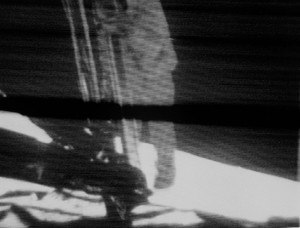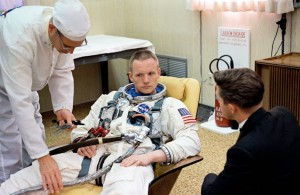Released this past Thursday, the movie First Man –directed by Damien Chazelle, written by Josh Singer, and based on the 2005 James R. Hansen authorized biography of Neil Armstrong bearing the same name – is not our generation’s Apollo 13 or The Right Stuff. This is not a criticism of the movie; while the film’s action sequences are unforgettable, First Man focuses on Armstrong’s arduous life from test pilot in 1961 to first man on the Moon in 1969. It is probably not the First Man that would have been envisioned, say, by Clint Eastwood (who originally wanted to direct the film), but those who are familiar with Armstrong’s story will understand that to address the man himself, you have to address the unique struggles he experienced from 1961 to 1969, the year he landed Eagle at the Sea of Tranquility. Note: minor movie spoilers included.
The film starts almost immediately depicting what would become the cruelest loss in Armstrong’s life: the illness and death of his toddler daughter, Karen. In mid-1961, according to Hansen’s biography, Karen – not yet aged two – was diagnosed with a type of brain cancer that was growing mid-brain stem. The particular cancer, a glioma, still carries a high rate of mortality even at present time. Despite a brief improvement after radiation treatment (which is depicted in all of its torturous, early 1960s reality in First Man), Karen’s health declined; in January 1962, Neil’s “Muffie” (his nickname for her) died of pneumonia, only six months following her diagnosis.
This sequence – Karen’s illness and demise – leads to a continuing metaphor in First Man. Before her death, we see Neil (played with appropriate understatement by Ryan Gosling) and Jan Armstrong (played by Claire Foy) peering through a thick glass partition as their daughter undergoes radiotherapy, isolated from her and her cries. During the reception following Karen’s funeral, a grief-stricken Neil shoves his engineer-concise notes about her treatment – and a sentimental keepsake of hers – in his office drawer, not to be seen again (at least for the time being). Neil’s feelings, his physicality, and the same qualities in his family and colleagues are separated from the outside world through a series of offices, drawers, hatches that open and close with metallic clangs (and in one awful case, hatches that can’t open), and windows; this motif underscores that while the cast of real-life characters might be held back by physical boundaries, the emotions are dangerously close to boiling past the carefully erected lines.
Was Neil profoundly affected by his grief in real life? A passage in Hansen’s book discussed a short vacation the family took to his hometown, Wapakoneta, Ohio, shortly following Karen’s death. Armstrong’s sister, June, related that a baby sheep had died at a local farm during his visit: “The men went out to the barn to attend to the dead lamb. My husband later told me that Neil could not go to the barn. Neil waited outside while the other men took care of the animal.” In the same chapter, June does state that “[t]he death of his little girl caused him to invest those energies into something very positive, and that’s when he started into the space program.”
It bears mentioning that Armstrong was not the only early space traveler to lose a young child. Gherman Titov, the second Soviet in space and second human to orbit the Earth in August 1961, lost a baby son, Igor, to a heart condition shortly before his only spaceflight. Donn Eisele, Apollo 7 astronaut, lost a young son, Matthew, to leukemia shortly before his 1968 spaceflight. It’s fair to say that each of these space travelers took something – even if it was just their own bodies – related to their deceased children into space. Eisele’s former wife, Harriet, related in the book In The Shadow of the Moon written by Colin Burgess and Francis French, “He did tell me that during the flight, he dreamed about Matt.”
However, Armstrong’s losses don’t end with his daughter’s death. While joining the astronaut program, we see Neil befriend a polite civilian astronaut named Elliot See, and a strapping Air Force pilot named Ed White. Gosling’s Armstrong enjoys warm friendships with both colleagues, spending time with their families, and enjoying beers with them on patios. But soon, the picture-postcard perfect suburbs are torn apart.In a doorway, White informs Neil of Elliot’s death by T-38 crash, and within months Neil receives the news of White’s horrifying pad fire death via rotary phone. Again, his reactions are barely felt, but still ever so noticeable. See’s death reminds Neil too much of his (still-ongoing) feelings about Karen, and when informed of White’s death, he inadvertently crushes his drinking glass, cutting his hand.
By this point, the movie has tackled the major conflict of man versus himself, but soon we are introduced to the conflicts of man versus machine, and man versus his own mortality. Another hatch closing signifies Neil’s (and Dave Scott’s) near-permanent exile to space, thanks to a stuck thruster during Gemini 8; more unforgiving metallic sounds signify that his training session with an LLTV in 1968 is about to go belly-up. While Neil has an understanding boss in Mercury 7 astronaut Deke Slayton (played by Kyle Chandler) and an ally in Jan, his sense of isolation (both technological and emotional) is intense and constant.
Without giving too much of First Man’s plot points away, Armstrong’s ultimate standoff with his feelings of grief occur on the Moon’s surface. After all of his work is done and he is contemplating the lunar vista by himself, he comes to accept the events that have taken place over the last decade of his life. This doesn’t make for a tidy ending, and it doesn’t even mean he’s “happy” about it. Acceptance doesn’t mean the one grieving is “done” grieving; it just means you have come to terms with the fact that things will never return to “normal,” and you won’t get back what you once had. Those who have suffered loss know that closure is a myth. And when he returns home, there’s still a glass window – literally and figuratively – between him and his wife, Jan.
While First Man might not be the Neil Armstrong movie people expected, it’s the one he deserves. It’s not about big statements or fanfare; it’s about one man’s journey through grief and acceptance. It is designed to make the viewer uncomfortable, but this lack of comfort was what shaped the early space program, for better and for worse.
 |
| NASA image, July 20, 1969: “Astronaut Neil A. Armstrong, Apollo 11 commander, descends the ladder of the Apollo 11 Lunar Module (LM) prior to making the first step by man on another celestial body.” |
Emily Carney is a writer, space enthusiast, and creator of the This Space Available space blog, published since 2010. In January 2019, Emily’s This Space Available blog was incorporated into the National Space Society’s blog. The content of Emily’s blog can be accessed via the This Space Available blog category.
Note: The views expressed in This Space Available are those of the author and should not be considered as representing the positions or views of the National Space Society.




















1 thought on “First Man Gives Insight Into Armstrong’s Exquisite Grief”